Food Photography, Anxiety, and Desire
Food photography is widely viewed but little studied field of visual culture, and this brief essay offers a welcome opportunity to revisit a topic I broached fifteen years ago in the photo journal Exposure.1 By the term “food photography,” I mean commercially produced photographs and photo essays that contain mini-narratives that appear in the editorial matter of popular food magazines, such as Bon Appetit (and many cookbooks), as distinct from both advertisements for food products and from photographs of food by art photographers.2 Analyzing the rhetorics of food photography in popular magazines, we can begin to understand the genre as a genre, identify the audience for these images, and investigate some provocative bleed-over from the worlds of technology and fine art into this enduring form of popular culture.
The visual rhetorics incorporated into these images trigger (in different ways) both physical appetite and social appetite, and their mechanisms for doing so appear to have remained constant in recent decades despite new competition from expansive digital venues. They incorporate power relations, aesthetic pleasure, and voyeurism. But food aesthetics are neither universal nor isolated; they echo (and feed) the cultural and political contexts in which they circulate so we can see change over time within underlying sameness.
In Landscape Theory, James Elkins reminds us that “Painting . . . has a recurring set of critical problems, including fictive space, the picture plane, the position and nature of the beholder, and notions of realism and representation.”3 What interested me initially about food photography was working out its paradigmatic “critical problems” and narrative conventions and linking them to real-world events on the one hand and, on the other, to the readers whose deeply engaged viewing was everywhere implied. I am interested in how the photographer, managing the “critical problems of photography,” positions the viewer, how she or he constructs a narrative, and how the visual image triggers desire and abates anxiety.
Food photography encourages us to see plated food as chromatically rich sculpture, as a key protagonist in social narratives, and uniquely, it allows us to examine gendered looking. Circulation figures make it clear that the implied gaze is female: 73 percent of the subscribers to “America’s #1 food magazine,” Bon Appetit, for instance, are women.4 Within this context, it is useful to consider Janice Radway’s classic Reading the Romance (1984, 1991), in which she does a remarkable reader-response analysis of romance novels as a literary genre, learning about the predicaments of the women who read them and the utility of their highly keyed fictional plots in helping women negotiate the disappointing reality of suburban lives. She alerts us to the “utopian longing” of those who “appropriate and use the mass-produced art of our culture . . . to imagine a more perfect social state as a way of countering despair.”5 While food photography is a visual rather than a literary genre, its overwhelmingly female audience and many of the operations of its conventions in terms of personal empowerment resonate with Radway’s romance novels and her findings. My working assumption is that magazine editors—necessarily motivated to deliver readers’ eyes to advertisers’ content on nearby pages—are especially alert to the ways social assumptions touch the real lives, fears, and fantasy aspirations of women in middle America. While the subject is food, the basic fact of appetite is entwined with complex webs of desire, displacement, suppression, and substitution.
In reviewing my initial analysis of the visual culture of food against current practice, I found that remarkably little has changed in the way food is presented in these popular magazines, in the conventions of the individual photograph, or in the linking of sequences of images into photo essays that read as narratives of place, of companionship, and of taste. After reviewing these enduring conventions, I will also consider the changes that have occurred in the way food is contextualized in these magazines and cookbooks today, specifically how this type of professional commercial image-making has responded to culture shifts, to new technologies, and to social practices.
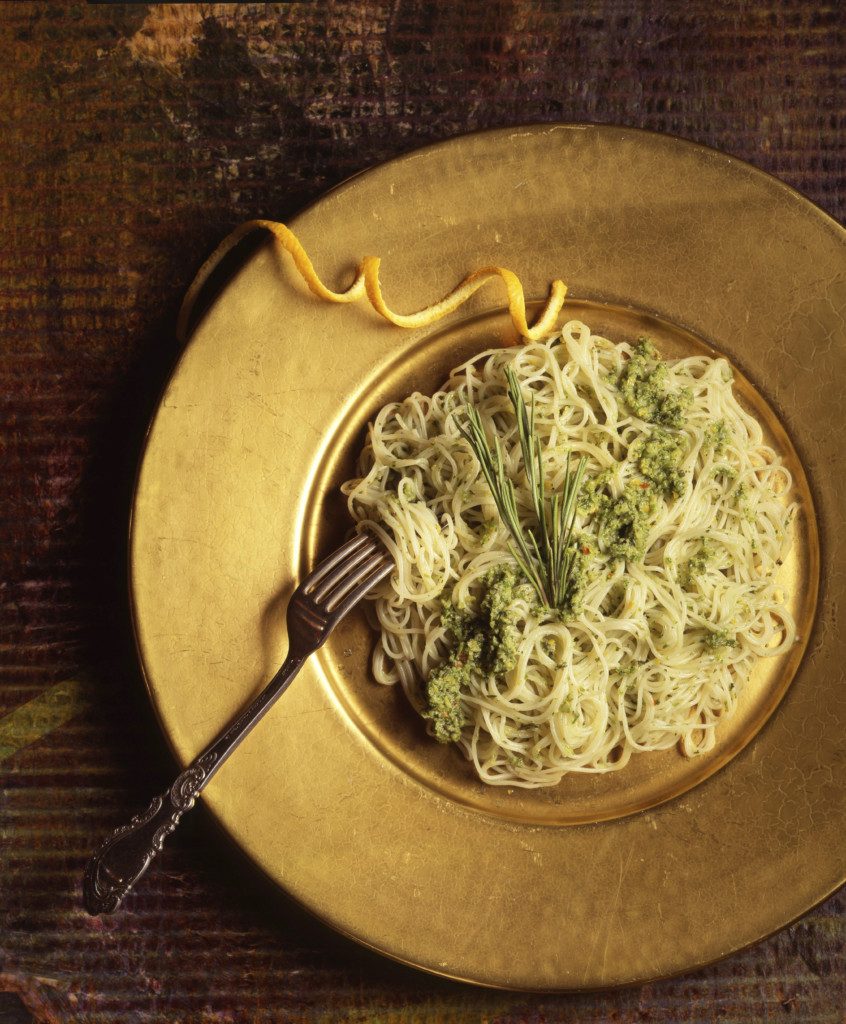
My initial question asked why the photo “Herbed Angel Hair”—that I propose is characteristic of late twentieth- and early twenty-first-century food photography—looks the way it does (fig. 1). What technical, rhetorical, psychological, and social considerations are embedded in, or suppressed by, this image? Its most self-evident characteristic is the almost one-to-one relationship between the image and the plate. This is a sharp-focus portrait taken under hot lights at life scale, rendering the slippery contours of entangled pasta, bright highlights on the silver fork, and subtle craquelure of the gilt lacquer wooden plate exceptionally vivid. Warm tones predominate, as does a leitmotif of spirals that echo through the circular plate, entwined pasta, a curl of orange peel, and rococo C- and S-scrolls on the fork. These visual rhymes dictate the logic of the image and unite disparate materials—gilded wood, steamy pasta, silver cutlery, and peeled orange—and disparate allusions—to ancient China, modern Italy, and to aristocratic eighteenth-century France. The image is a symphony about interesting variants on circles, gyres, and spirals, about the present that exists in relation to both the immediate narrative of an elegant dinner with an implied companion, and the longer historic narratives of culture contact and cultural appropriation of distant places and regimes. The eye of the lens, and thus the eye of the viewer, is directly overhead. This is the view of the eater, a fact reinforced by the curl of pasta on the fork signaling that, temporally speaking, this image records the critical moment before a first bite has been taken, the moment of maximum anticipation and desire. The photographer controls the scope and range of the viewer’s attention by selective focus; for instance, in “Herbed Angel Hair,” the dark mat under the plate is evident only as a rough, warm, slightly out-of-focus ground plane, an object of less than tertiary interest.
In architectural terms we can speak of the overhead view as a “plan,” the end-on view of, for instance, a sandwich as an “elevation,” and the oblique assembly of several related plates as a “perspectival view.” Of these, the plan and elevation are the most powerful, as they are the most suggestive of immediate eating. With scale, visual rhyme, selective focus, and a calculated point of view, the photographer (in collaboration with cooks, food stylists, decorative arts specialists, and editors) controls the viewer’s gaze, and of course the gaze is not neutral.6 As theorized by Laura Mulvey and others, the gaze in film and most other pictorial art forms is gendered male, an I-it power relationship.7 That the gaze in food photography is gendered female gives us an unusually raw instance of the empowered gazer seemingly on the brink of consuming the object of her attention. But like Radway’s romances, the fantasy proffered is exactly that—a fiction that women experience vividly but vicariously, one that does not compromise the social self. Food, for American women, of course is dangerous, a realm in which physically indulging one kind of appetite and pleasure risks diminishing the physical desirability of the self in the view of others’ appetite and pleasure. In other words, food photography echoes the paradox many American women face and negotiate daily: a “utopian longing” (to use Radway’s term) for indulgence, and anxiety about indulging too much.
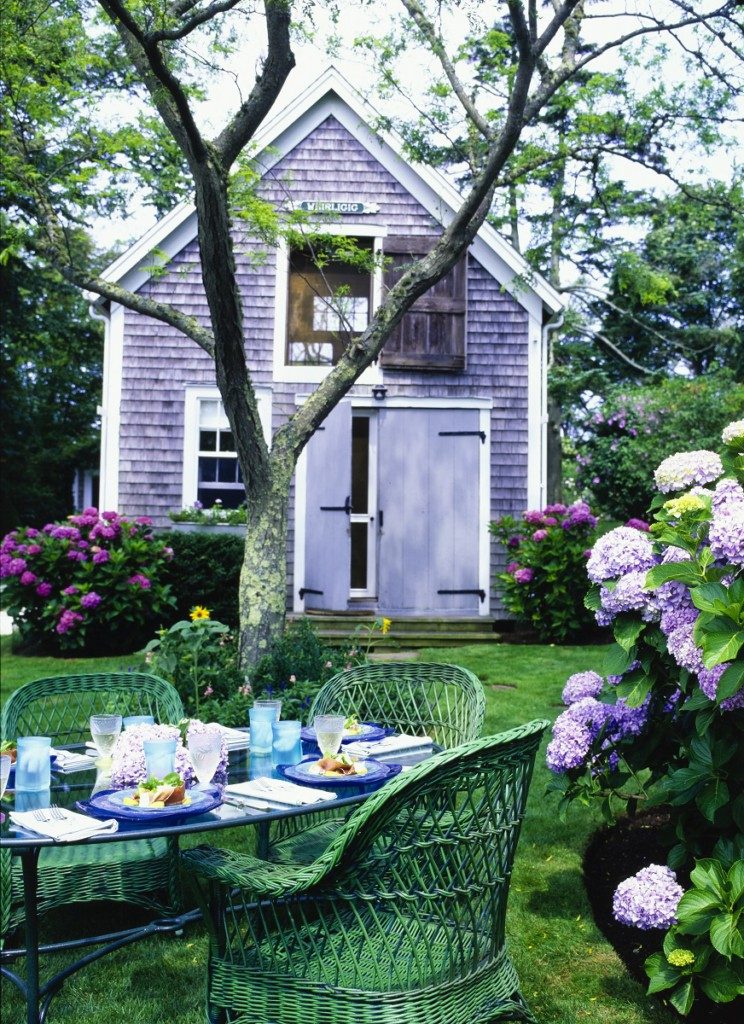
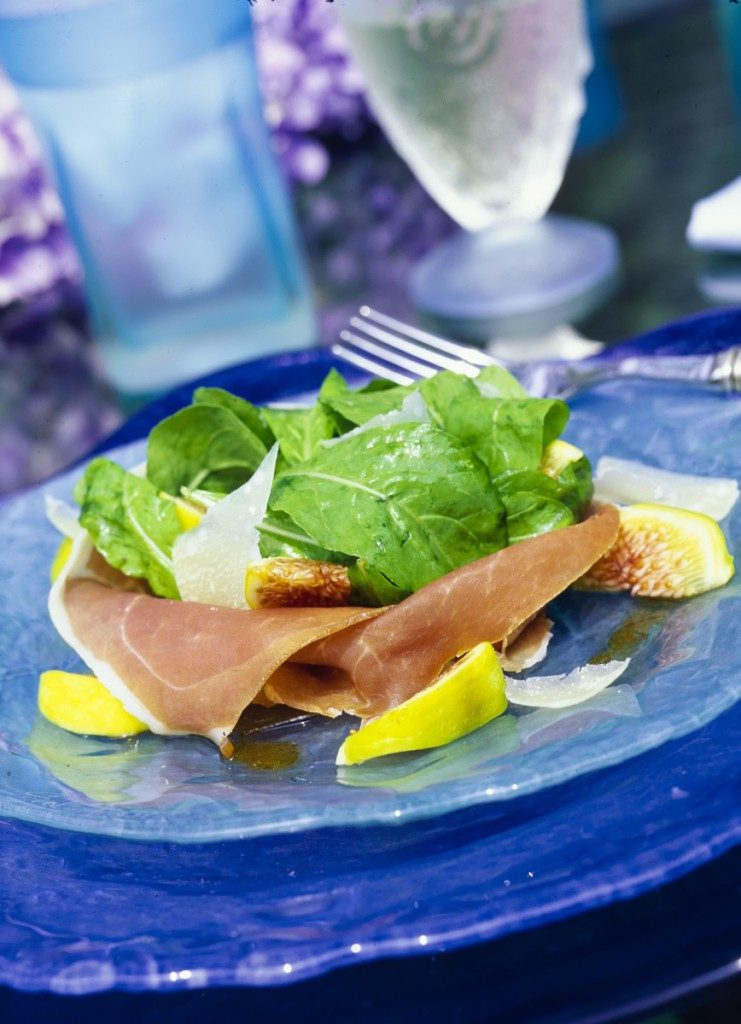
Food photographs in the editorial pages of food magazines (and travel magazines, as these are as focused on food as on sights), are usually contained within two- to six-page stories, and those narratives have a characteristic structure. “Lunch Among the Hydrangeas,” which appeared in Gourmet in July 1998, for instance, begins with an establishing shot: a distinctive shingled Nantucket building, a garden, and a table on which lunch awaits (fig. 2). The vehicle is the picture; the world on offer is deeply desirable but also one seemingly within reach. Physically situated in culturally recognizable settings, the central idea of these pictorial narratives is profoundly social as well as gustatory. The table is set for four; it is always an even number. Food magazines understand humans to exist in pairs and to socialize in multiples of pairs. An odd number of chairs and place settings would invite the viewer to imagine distracting subplots and potentially suggest social discomfort. While the table settings promise companionship and conversation, these images tend to be devoid of human actors. It is the viewer’s role to fill that void and vicariously engage in a desirable life (often indicated architecturally) with a soulmate or a set of companions (usually indicated in place settings). It is characteristic that the title of this image points to the meal and to a desirable physical place, in this case the garden of an island summer home in which hydrangeas bloom. But the implied ideal companions who complete the picture—people to vacation, sail, eat, have sex with—is left to the viewer to conjure. So in one sense these images are very literal and descriptive, and in another, they elide much.
Beyond the establishing shot that provides a desirable architectural and landscape setting, these photo essays always include—indeed foreground—portraits of specific dishes in minute, usually full-scale detail. In “Lunch Among the Hydrangeas,” this is a full-page gorgeous photo ‘bleed’ of the luncheon that has been plated in this garden (fig. 3). The viewer’s experience is carefully orchestrated—the photographer has used a very shallow depth of field; this selective focus keeps one’s eye on the food. Even the fork—critically poised on the edge of the plate—is beyond the range of sharp focus. And note the use of color opposites. The orange of the prosciutto vibrates against the blue of the plate, and the red of the fig interior vibrates against the green of the arugula leaves. What these colors do to each other was called by its discoverer in 1839, Michel Eugène Chevreul, a French textile administrator, the Law of Simultaneous Contrast.8 In short, orange will always appear more vivid if next to blue; green will be brighter next to red; and purple will brighten yellow. This optical effect has become a mainstay strategy of food photographers. The vividness of this image is, then, a result of hot lights, sharp focus, shallow depth of field, and large scale as well as this vibrant color contrast. The intent is to encourage the viewer to taste the dish with her eyes. The viewer is in a position of power over the as-yet-untasted food, a player in the narrative on the point of realizing her desire of consuming the object of her gaze in the company of ideal companions. What is going on here with the establishing shot and the following close-ups is the splicing of two related narratives of desire: food desire and desire for a summer place where an ideal self with ideal companions converse and consume a beautiful meal that appears without labor.
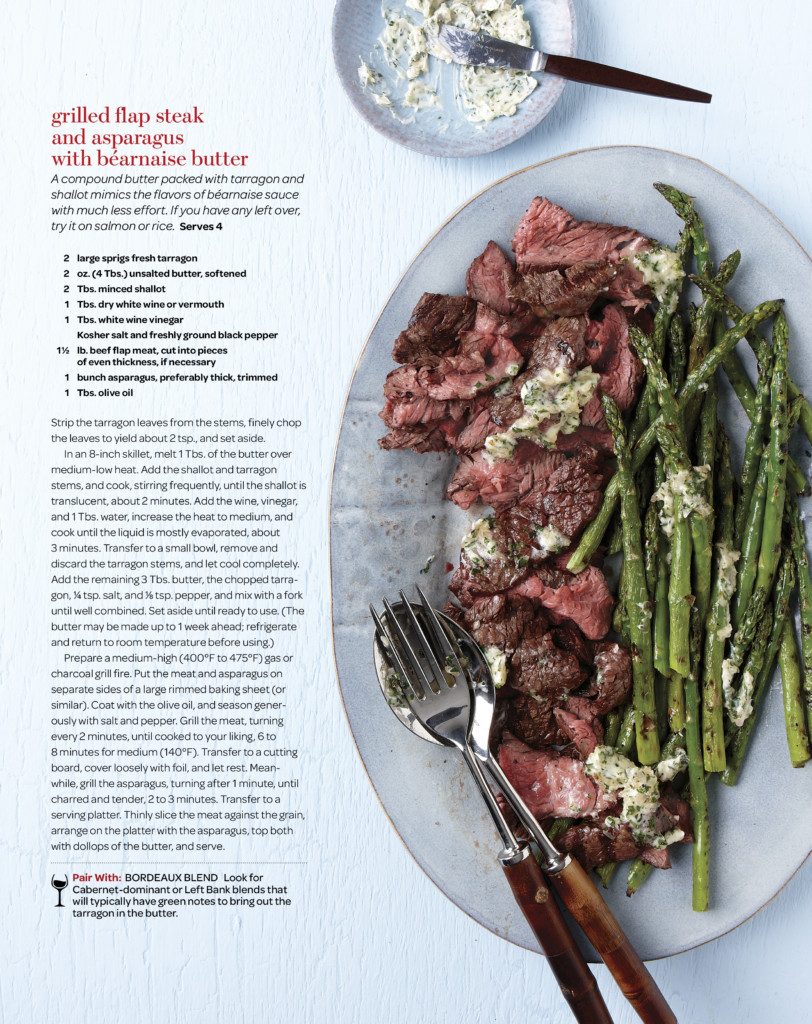
One of the major developments in the last decade is the tendency of food magazines to print the text of recipes next to, or even onto, the photos rather than in the back pages. In “Grilled Flap Steak and Asparagus with Béarnaise Butter” from Fine Cooking (June/July 2016), for instance, the serving plate is offered at life scale, the point of view is overhead, the focus is selective and precise, the red of the beef amplifies the glistening green of the asparagus—all of this is familiar—but next to the dish, a long column of text disrupts the fantasy (fig. 4). In the imperative voice, the reader is instructed to achieve this culinary offering rather than linger in the fantasy of its eternal perfection. No doubt in response to readers’ affirmations that they did not want to just see the food, they actually wanted to make it, and to do so with the immediacy of the photograph in sight instead of having to ferret out the recipes in the ignominious back pages, this shift in graphic presentation disrupts the temporally specific perfected moment of the pictorially offered meal.
Some food magazines, such as Epicurious, have resolved this problem by placing buoyant full-scale photo bleeds on one side of the open two-page spread while the recipes appear in tidy sans serif type on a crisp, spare white opposing page—a pairing of two kinds of visual experience that are designed not to compete with one another.9 Martha Stewart Living provides two other strategies that keep the photographs clear of intrusive text but near cooking instructions: in the November 2016 issue, for instance, following six pages of full-scale thematically linked elaborate pies, two dense but elegantly designed pages give pictorial directions for their achievement.10 Secondly, at the center of the magazine, four photographs of disparate dishes are printed on heavy card stock with the recipe for each dish printed on the back; the sheet is perforated for separation from the magazine and into index card-size personal recipe files.
Food magazines always provide instructions, recipes, and menus in some form to help the reader achieve the pictured meal as well as visually consume it, if desired. But the necessary labor of food preparation (planning, shopping, peeling, shucking, chopping, blanching, boiling, braising, etc.) is only gestured at, and the implied agricultural labor (harrowing, planting, weeding, picking, drying, winnowing, threshing, milling, breeding, feeding, castrating, butchering, etc.) is invisible. Even more suppressed are the facts of the biological food cycle.
The food photograph captures a particular moment in the food cycle—the moment when hunger and the desire for ideal sociability are about to meet satisfaction. It can provide satisfaction for the eye and the mind; it can provide calorie-free aesthetic pleasure. In postponing appetite satisfaction, it also keeps desire eternally at the point of critical and pleasurable anticipation. At the same time, it vigorously suppresses the food cycle narrative.
The moment of presentation of prepared dishes at the table is the perfected and most critical part of this larger biological narrative. Artfully prepared food pictured on the cusp of consumption is fixed at one moment in a narrative that is unpictured, but which we cannot not know. Food makes a journey from disorder (in the field) to order (at the table), back to disorder (in digestion of food eaten). All signs of inedible parts and all signs of labor and violence are strictly edited out. The agricultural product is now food and it is presented to the viewer of the photo to maximize desire. At the table, food is consumed and reenters the realm of disorder, and therefore behavior taboos underline the fact and the meaning of this counter-narrative, the biological food cycle. We also have related language taboos. We never see “pig” or “swine” on the menu—these are Anglo-Saxon words, and when the Anglo-Saxon King Harold was defeated in 1066 by Norman-French William the Conqueror, Anglo-Saxon words were demoted to the barnyard and the peasantry, while the French word “pork” was used at the table and by aristocrats. Similarly we eat “beef” from the French boeuf rather than “cow” or “cattle”—Old English terms that remain barnyard, not menu, words for the same thing. Similarly, food critics speak in the semiabstractions and metaphors of palate and taste; they do not mention tongue, teeth, chewing, or even lips, as these crucial instruments of eating are suggestive of dismemberment and the beginning of digestion.
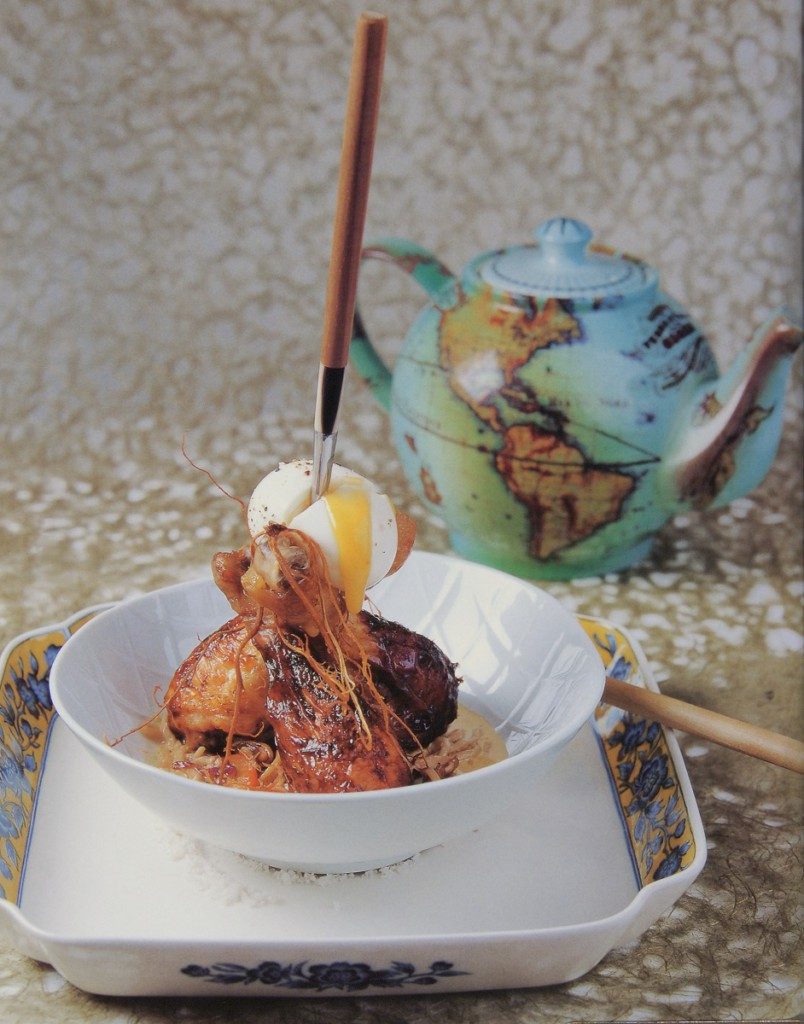
Postmodern food, like postmodern architecture, displays quirky, unexpected combinations of textures and materials; its visual quotations are witty. It eschews the geometric precision of modernism (as in a perfect cylindrical cake) and tends to be presented in gravity-defying vertical assemblages. It does not lie passively on the plate but stands erect, defying both gravity and our expectations. More important, it teases that critical border I have been insisting on between the raw and the cooked, the inedible and the edible, the disordered and ordered. In “Three-legged Chicken with Soft Boiled Egg,” which appeared in Art Culinaire in the winter 1998/99 issue, three drumsticks are trussed together to form a kind of pedestal or platform for a soft-boiled egg (fig. 5). The eating implement here is not just lying provocatively on the plate like that rococo fork in “Herbed Angel Hair,” it is visibly “digging in” to the egg, causing it to “bleed” over the parent chicken. This is a rare but interesting instance in which food presentation begins to self-consciously press its own conventions. Needless to say, such culinary experiments are infrequent in magazines aimed at middlebrow householders.
Food in editorial food photography is never branded. That is the province of the advertisements on adjacent pages. Food pictured in the context of brand-pushing follows very different rules than those discussed above. The project in advertising is to associate pleasure with a package and a commodity name. The strategies often involve putting the food in motion (bursting, pouring, splashing) and almost always include beautiful people, portrayed by professional models, in the scene. We are positioned as viewers of the action, not eaters. Without thinking, one can instantly recognize the different rhetorical devices and never confuse editorial photo essays with advertisements, even though the latter are often deliberately keyed to the former.
If the introduction of written-out matter-of-fact how-to recipes directly onto the field of the dramatic photograph—as seen in “Steak Asparagus”—is the first important development in recent food photography, the occasional introduction of human actors is the second (fig. 4). Figures tend, however, to be ordinary people rather than beautiful actors—most often restauranteurs, cooks, fishmongers, wine-making peasants, baristas, and others whose livelihood involves food, and who the viewer can read as service providers. Recently, food photographs have introduced hands, signaling seemingly more informal photo shoots among actively gregarious young diners, such as those seen in “Photographing the Pizza” in the March 2016 Bon Appétit (fig. 6).11 At first blush, this image, suggestive of hip single twenty-somethings, seems an odd photograph to feature on the contents page of this food magazine, given that the readership of Bon Appétit is 73 percent female, 60 percent married, and, in terms of age, pushing fifty. But clearly this is an editorial bid by Bon Appétit to stir interest among millennials. Blue fingernail polish, allover tattoos, and, well, pizza do not fit neatly into the fantasy meals and companions of the established readership demographic of the magazine.12 The project is clearly an attempt to expand that demographic to include younger adults. Of course, the real subject of this image in which ten pizzas and five hands compete for our attention, is the iPhone; a professional photographer alludes to and mimics the novel ubiquity of amateur food photography for social media circulation. Until the development of the smartphone in 2007, taking food photographs involved specialized lenses as well as tripods, photo lights, and a crew of food stylists and others. But now, the artwork that is food—both at home and restaurant meals—can be easily captured and shared. Snapshot food photography has become part of self-presentation, daily posts, and competitive likes on social media. However, as another page in this issue makes clear, the conventions of Instagram photography follow those long established by the professionals, including the overhead “plan” view, the absence of bite marks, and the preference for foods that exhibit color opposites to “make my meal kind of ‘pop up.’”13 The object for many is to post photos that receive lots of attention (countable hits), not to share recipes or even the social occasion so obliquely recorded.
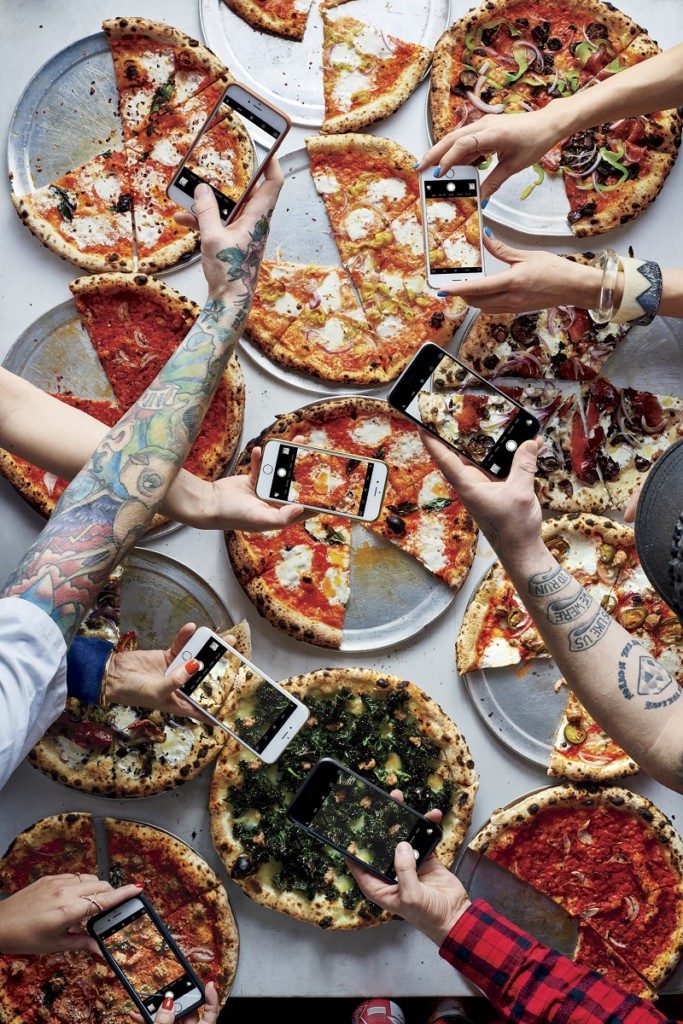
One wonders why in this digital age, with so much food information and imagery circulating online, these magazines continue to prosper. One answer is suggested by the metrics publicized by Saveur, whose readers’ household income is reportedly $158,942 (by comparison, Bon Appétit’s subscribers are reported to have a $91,879 median household income).14 Saveur reports in its 2017 Media Kit that while many more individuals look at Saveur online, where one can scroll through small-scale photos and access recipes, the average time online viewers spend is just six minutes, likely in pursuit of a specific recipe.15 By contrast, they report that their hard-copy subscribers spend an average of ninety-five minutes with each issue, and so clearly these readers have more opportunity to savor the photo essays, and their advertisers have more opportunity to catch the interest of those who dwell on every page. Such disparity between viewer categories suggests that hard-copy subscribers are not just looking for cooking information. Their slow experience of luscious full-page bleeds on the highest-quality coated paper, of photo essays that encourage the viewer to imaginatively inhabit a different, more upscale, exotic, interesting place, indicate that the reading experience of well-crafted food magazines, with all the conventions of food photography in full operation, is akin to that of Radway’s readers of romance fiction. It is a kind of entertainment that helps them manage the here and now by providing access to a radically alternative kind of imaginative experience.
Beyond the text and picture layout and the acknowledgment and embrace of the importance of amateur smartphone food photography, recent trends in food magazines include updated ideas about the relationships between food and earth and the body. Some photo essays, for instance, evidence consciousness of finite resources, although, interestingly, most locavore-oriented essays concern non-United States sites, where eating local produce is presented as a key aspect of traditional foodways rather than as an ethical decision to reduce greenhouse gases produced by long-distance transport of food items in this country.16 Similarly, food magazine editors take for granted that their readers are well read in serious food journalism concerning the relationships between agriculture, fast foods, the American diet, and health. They assume that, in particular, subscribers are acquainted with the prizewinning books by Michael Pollan, a professor at the University of California, Berkeley, and will enjoy references to and spoofs of his research and wisdom.17 There is a quiet note, in other words, in these recent issues suggesting that personal food choices may help save the planet and improve health as well as provide radiant visual experiences.
But much remains unchanged. Interestingly, what people busy with their iPhones do not do is make candid shots of their friends eating, or competitive selfies actually biting into or chewing—that is, actually enjoying—their food. Indeed, showing the actual consumption of food remains somehow unpicturable and unappetizing. Why, one wonders, is the photograph of a beautiful actress with a handsomely presented meal at an upscale white-tablecloth restaurant actually eating, included by the New York Times in a “sampler of memorable images from the year in culture” (fig. 7)? What singles this picture out for a December 31 gathering of singular photographs from 2016 is that it captures exactly the moment in the food cycle that people, especially women, worry the most about. Despite the strong desire for sociability and food demonstrated by the existence, management, and wholesale embrace of the food photography genre as practiced by American food magazines, those who create these photo essays know that their female viewers are reluctant to be seen, or to imagine themselves being seen “stuffing one’s face.” Eating is an ordinary activity that raises anxiety in women who, generally, from childhood, are schooled in the “double consciousness” of not only being conscious of inhabiting a self, but also hyperconscious of inhabiting a body being watched and judged. The case of Kate McKinnon being photographed eating noodles in public skims that borderline and captures taboo picturing where the viewer’s social anxiety begets comedy, for McKinnon is a comedian. The photograph is “memorable . . . from the year in culture” not because it shows anything remarkable, but because it pictures the wrong moment for picturing. It is as though McKinnon has upended the rhetorics and conventions so eloquently exhibited in “Herbed Angel Hair” (fig. 1). Our only available responses are disgust or amusement.
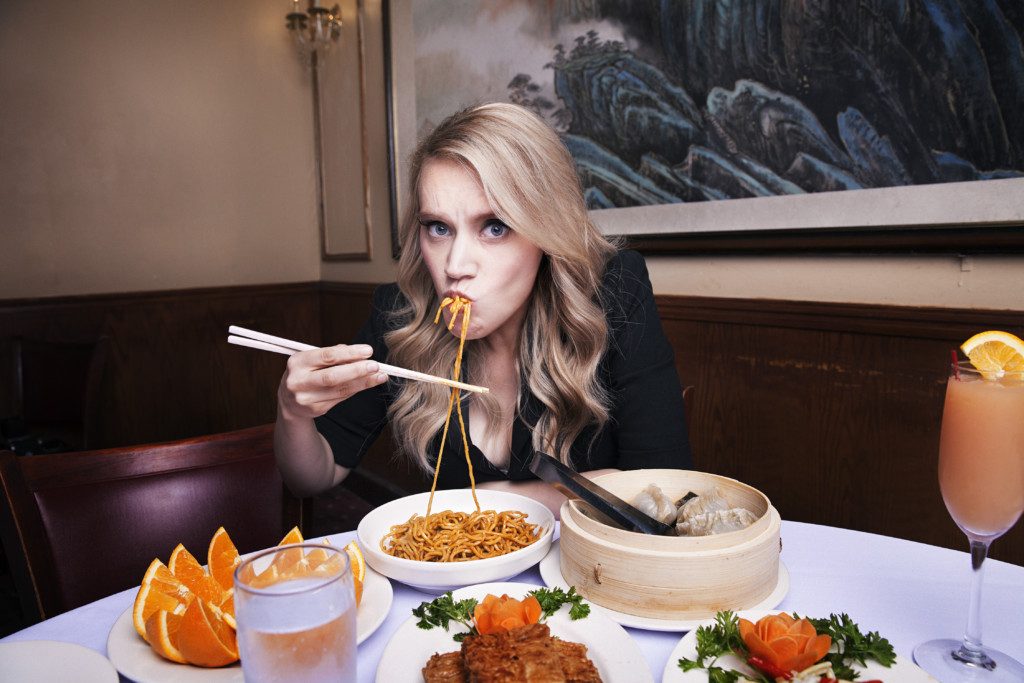
Food photography, and the food and travel magazines that package it for a ready audience, is useful. It serves up an ever-various but predictable set of images ready to transport its target reader to a place outside the home, hair salon, commuter bus, or dentist’s office in which it is read. Its plot is always the same—beautiful food enjoyed in sociable and interesting contexts—where the labor of meal production and the facts of the biological food cycle are carefully suppressed. Only secondarily about the pleasures of cooking, what these photographs and photo essays underline is yearning for ideal companionship, leisure, and aesthetic experience.
Cite this article: Margaretta M. Lovell, “Food Photography, Anxiety, and Desire,” in “The Gustatory Turn in American Art,” Panorama: Journal of the Association of Historians of American Art 3, no. 2 (Fall 2017), https://doi.org/10.24926/24716839.1609.
Notes
- Margaretta M. Lovell, “Food Photography and Inverted Narratives of Desire,” Exposure 34 (Summer 2001): 19–24. ↵
- For an assemblage of photographs of food by art photographers, see Susan Bright, Feast for the Eyes: The Story of Food in Photography (New York: Aperture, 2017). ↵
- James Elkins, “Writing Moods” in Rachel Ziady DeLue and James Elkins, Landscape Theory (New York: Routledge, 2008), 70. ↵
- See https://prezi.com/ohv3ten kprkg/bon-appetit/ (accessed July 17, 2017); and “Bon Appetite Magazine Social Metrics,” at http://justmediakits.com/mediakit/1363-bon_appetit.html (accessed July 17, 2017), lists no figures under “Demographics/Readers,” simply the word “Women.” ↵
- Janice Radway, Reading the Romance: Women, Patriarchy, and Popular Literature (Chapel Hill: University of North Carolina Press: 1984, 1991), 222. ↵
- For a primer on food styling, see John F. Carafoli, Food Photography and Styling (New York: Watson-Guptill Publications, 1992). ↵
- Laura Mulvey, “Visual Pleasure and Narrative Cinema,” Screen 16, no. 3 (1975):14–28, reprinted in Laura Mulvey, Visual and Other Pleasures (London: Macmillan, 1989); see also E. Ann Kaplan, “Is the Gaze Male?” in Women and Film: Both Sides of the Camera (New York: Methuen, 1983), 23–35; Edward Snow, “Theorizing the Male Gaze: Some Problems,” Representations 25 (Winter 1989): 30–41; Jacqueline Rose, Sexuality in the Field of Vision (London: Verso, 1986), 225–33. ↵
- Michel Eugene Chevreul, The Principles of Harmony and Contrast of Colours and Their Applications to the Arts. . . , trans. Charles Martel (London: Henry G. Bohn, 1860) ↵
- See, for instance, the Spring 2016 issue of Epicurious, although it should be mentioned that the editors retreated from this clearly expensive design for the Fall 2016 issue. Saveur keeps the full bleeds in many photo essays. ↵
- “November Everyday Food,” and “A Round of Applause,” Martha Stewart Living no. 269 (November 2016): 77–86 and 90–97. ↵
- See also the opening page of Gabrielle Stabile, “Garden Fresh Vegetables,” Gourmet Summer Classics (Summer 2016): 48–49. ↵
- See Matt Duckor, “A (More) Perfect Union,” Traveler: The Food Issue (October 2016): 96–194, esp. 99, which features a similar faux snapshot by photographer Linda Pugliese of an iPhone photo being taken of a much more upscale meal by young businessmen about to enjoy expensive bottles of wine and overflowing plates of pork in Tuscany. ↵
- “You Got the ‘Gram, Right?,” in Bon Appetit 61 (March 2016): 77. ↵
- http://www.bonniercorp.com/wp-content/uploads/2017/01/SAV17_MediaKit.pdf, (accessed July 12, 2017); https://prezi.com/ohv3ten kprkg/bon-appetit/ (accessed July 17, 2017). ↵
- http://www.bonniercorp.com/wp-content/uploads/2017/01/SAV17_MediaKit.pdf (accessed July 12, 2017). ↵
- See, for instance, David Prior, “Fish, Forage, Feast Connemara,” Traveler (October 2016): 78–79. ↵
- See for instance, Ben Schott, “Do You Recognize One of these 27 Omnibores?,” Bon Appétit 61 (March 2016): 75. ↵
About the Author(s): Margaretta M. Lovell is the Jay D. McEvoy Jr. Professor of American Art at the University of California, Berkeley.

